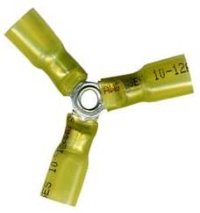Kenneth is spot on. I have had a wire come loose and short circuit on the engine block, and then melt its way through the starter cable, with the first alert being the sound of the starter turning along with the cabin filling with smoke. The solution was to run the starter cable through a 100A circuit breaker, which is not standard procedure but it worked.
If, as it appears, every circuit is fused at the panel then the extra fuse is counterproductive since it creates more unprotected wire rather than less, and, as Kenneth has pointed out, that unprotected wire is flapping around above the battery negative terminal. The extra fuse would only be necessary if the fuse panel were somewhere else in the boat and there were a long run of wire to get to it.
Nigel Calder writes some confusing things sometimes, and does not get everything right (I say that as a physicist who has wired some albeit small components on a tokomak nuclear fusion reactor); the important point is that every circuit needs to be on a fuse in case of either a malfunction in an electrical component or a short circuit developing due to damage to the wiring. The size of the fuse is determined by the maximum current that is going to run through the circuit as determined by the component it feeds. The size of the wiring is determined by the voltage drop that will occur when that current runs along the length of the circuit.
Either run a secured wire straight from the battery terminal to the fuse panel, which is legal as per ABYC since it is less than a 7" run as Nick has pointed out, or better still take Kenneth's suggestion, which pretty much eliminates any risk, of a fuse right on the battery terminal (and then make sure the wire from it to the fuse panel is secured).
Gareth
Freyja E35 #241 1972











